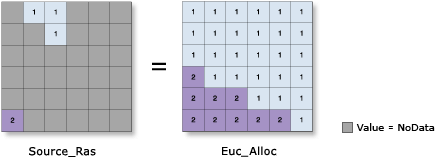Calculates, for each cell, the nearest source based on Euclidean distance.
Legacy:
The Distance Allocation function provides enhanced functionality or performance.

This is a global raster function.
Notes
The input source data must be a raster layer.
The NoData values that exist in the Source Raster are not included as valid values in the function. The value 0 is considered a legitimate value in the source raster. A Source Raster can be created using the extraction tools or the Clip function.
If you have source features, you can first convert them to a raster dataset using the Rasterize Features function. Use a consistent input for the Raster input to that function. This will ensure that the features are properly converted to a raster dataset using the same cell size, extent, and spatial reference.
The Maximum Distance is specified in the same map unit as the Source Raster.
The Value Raster is useful if the Source Raster was derived from an operation that resulted in Boolean cell values. These operations cause the Source Raster to lose the original zone values that were associated with the source cell locations. The Value Raster can either restore these cell values or allow analysis on additional combinations of zone values within the source cells. If the Value Raster is used, it may change the configuration and results of the output.
If the Mask has been set in the geoprocessing environments, and the cells to be masked will cover a source location, the Euclidean calculations will occur on the remaining source locations. The source cells that are masked will not be considered in the computations; these cells will be assigned a value of NoData. Any cell location that is assigned NoData on the input surface will receive NoData on all the output rasters. See Analysis environments and Spatial Analyst for additional details on the geoprocessing environments that apply to this function.
Parameters
| Parameter name | Description |
|---|---|
Source Raster (Required) | A raster dataset that identifies the source locations. Based on Euclidean distance, the nearest source will be determined for each cell in the output The input type can be an integer or a floating-point type. |
Source Field | The field used to assign values to the source locations. It must be an integer type. If the Value Raster has been set, the values in that input will take precedence over any setting for the Source Field. |
Raster Barriers | The raster that defines the barriers. The dataset must contain NoData where there are no barriers. Barriers are represented by valid values including zero. The barriers can be defined by an integer or a floating-point raster. |
Maximum Distance | Defines the threshold distance within which the nearest source will be determined. If the distance to the nearest source exceeds this, the output for that cell will be NoData. The default distance is to the extent of the output raster. |
Value Raster | The input integer raster that identifies the zone values to be used for each input source location. For each source location cell, the value defined by the Value Raster will be assigned to all cells allocated to the source location for the computation. The Value Raster will take precedence over any setting for the Source Field. |
Cellsize | The cell size at which the output raster will be created. If the cell size was explicitly set in Environments, that will be the default cell size. If it was not set, the output cell size will be the same as the Source Raster. |
Distance Method | Determines whether the distance will be calculated using a planar (flat earth) or a geodesic (ellipsoid) method.
|